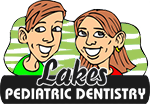Q: What should I do in the event of a dental emergency?
A: If your child is experiencing a dental emergency, please call our emergency line at (248) 345-6775. We will make every attempt to accommodate your child and may be able to hold after-hours visits depending on the severity of the problem.
Q: When should my child start brushing and flossing?
A: Brushing should begin as soon as the first tooth emerges. Using a small, soft brush and a tiny amount of toothpaste, gently brush all sides of the teeth and gums. Flossing should begin wherever two or more teeth touch. You should brush and floss your child’s teeth until he or she is able to do it alone, around age 6.
Q: Are candy and snack foods safe?
A: Candy and snack foods can often do the most damage to teeth due to the sticky, sugary residue they leave behind. It’s important for your child’s teeth to be brushed after eating these treats. If that isn’t an option, then it’s a good idea for your child to rinse his or her mouth out with water in order to remove as much sticky residue as possible.
Q: How and when should I begin to care for my baby’s oral hygiene?
A: It’s important to care for your baby’s mouth even before the teeth emerge, as a clean, healthy mouth means strong, healthy teeth will grow in. Simply dampen a soft piece of cloth or gauze with warm water and wrap it around your index finger. Then, gently rub the cloth over your baby’s gums to clean them. It’s best to do this twice a day, or at least after feedings and before bed.
Q: How much fluoride is enough for my child?
A: It’s important not to use too much fluoride toothpaste when brushing your child’s teeth; a pea-sized amount is safe for children three and older. Fluoridated drinking water also helps prevent cavities.
Q: What are sealants?
A: If your child has newly erupted adult molars, we suggest coming in for a sealant application. This is a clear plastic that is applied to the teeth to help protect against cavities, as the sealant can flow into the nooks and crannies on the chewing surface of the teeth where bacteria can hide.
 Directions
Directions